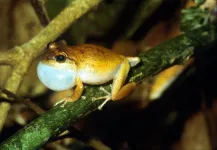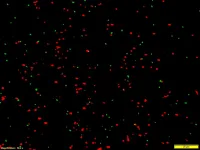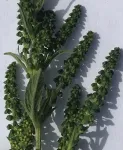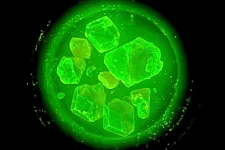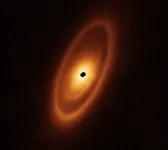(Press-News.org) COLUMBUS, Ohio – Astronomers have revealed new evidence about the properties of the giant bubbles of high-energy gas that extend far above and below the Milky Way galaxy’s center.
In a study recently published in Nature Astronomy, a team led by scientists at The Ohio State University was able to show that the shells of these structures – dubbed “eRosita bubbles” after being found by the eRosita X-ray telescope – are more complex than previously thought.
Although they bear a striking similarity in shape to Fermi bubbles, eRosita bubbles are larger and more energetic than their counterparts. Known together as the “galactic bubbles” due to their size and location, they provide an exciting opportunity to study star formation history as well as reveal new clues about how the Milky Way came to be, said Anjali Gupta, lead author of the study and a former postdoctoral researcher at Ohio State who is now a professor of astronomy at Columbus State Community College.
These bubbles exist in the gas that surrounds galaxies, an area which is called the circumgalactic medium.
“Our goal was really to learn more about the circumgalactic medium, a place very important in understanding how our galaxy formed and evolved,” Gupta said. “A lot of the regions that we were studying happened to be in the region of the bubbles, so we wanted to see how different the bubbles are when compared to the regions which are away from the bubble.”
Previous studies had assumed that these bubbles were heated by the shock of gas as it blows outward from the galaxy, but this paper’s main findings suggest the temperature of the gas within the bubbles isn’t significantly different from the area outside of it.
“We were surprised to find that the temperature of the bubble region and out of the bubble region were the same,” said Gupta. Additionally, the study demonstrates that these bubbles are so bright because they’re filled with extremely dense gas, not because they are at hotter temperatures than the surrounding environment.
Gupta and Smita Mathur, co-author of the study and a professor of astronomy at Ohio State, did their analysis using observations made by the Suzaku satellite, a collaborative mission between NASA and the Japanese Aerospace Exploration Agency.
By analyzing 230 archival observations made between 2005 and 2014, researchers were able to characterize the diffuse emission – the electromagnetic radiation from very low density gas – of the galactic bubbles, as well as the other hot gases that surround them.
Although the origin of these bubbles has been debated in scientific literature, this study is the first that begins to settle it, said Mathur. As the team found an abundance of non-solar neon-oxygen and magnesium-oxygen ratios in the shells, their results strongly suggest that galactic bubbles were originally formed by nuclear star-forming activity, or the injection of energy by massive stars and other kinds of astrophysical phenomena, rather than through the activities of a supermassive black hole.
“Our data supports the theory that these bubbles are most likely formed due to intense star formation activity at the galactic center, as opposed to black hole activity occurring at the galactic center,” Mathur said. To further investigate the implications their discovery may have for other aspects of astronomy, the team hopes to use new data from other upcoming space missions to continue characterizing the properties of these bubbles, as well as work on novel ways to analyze the data they already have.
“Scientists really do need to understand the formation of the bubble structure, so by using different techniques to better our models, we’ll be able to better constrain the temperature and the emission measures that we are looking for,” said Gupta.
Other co-authors were Joshua Kingsbury and Sanskriti Das of Ohio State and Yair Krongold of the National Autonomous University of Mexico. This work was supported by NASA.
#
Contact: Smita Mathur, Mathur.17@osu.edu
Written by: Tatyana Woodall, Woodall.52@osu.edu
END
Galactic bubbles are more complex than imagined, researchers say
Fresh look at old data reveals novel details about galactic formation
2023-05-08
ELSE PRESS RELEASES FROM THIS DATE:
Baylor researchers explore effect of Instagram, TikTok on psychological well-being
2023-05-08
Contact: Kelly Craine, Baylor University Media and Public Relations, 254-297-9065
Follow us on Twitter: @BaylorUMedia
WACO, Texas (May 3, 2023) – Instagram and TikTok are two of the fastest-growing social media outlets in the U.S., offering entertainment and connection to a world-wide community with the ease of a finger swipe. Despite their growing popularity, little research has focused on the association between the specific use of Instagram and TikTok and a person’s psychological well-being.
Noted Baylor University smartphone researchers Meredith E. David, Ph.D., ...
Warmer climate could cause Puerto Rico’s frogs to croak #ASA184
2023-05-08
CHICAGO, May 8, 2023 – The coqui frog is one of Puerto Rico’s most iconic animals. It gets its name from its distinctive two-note call, “co-qui,” which can be heard throughout the island every night. The males of the species produce these calls to mark their territory and ward away rivals, but scientists can also use them to study the changing climate.
Peter Narins of the University of California, Los Angeles will describe changes in the calls of the coqui frog over a 23-year period in his talk, “Climate change drives frog call change in Puerto Rico: Predictions and implications.” The presentation will take place Monday, ...
Smallest shifting fastest: Bird species body size predicts rate of change in a warming world
2023-05-08
Photos
Birds across the Americas are getting smaller and longer-winged as the world warms, and the smallest-bodied species are changing the fastest.
That's the main finding of a new University of Michigan-led study scheduled for online publication May 8 in the journal Proceedings of the National Academy of Sciences.
The study combines data from two previously published papers that measured body-size and wing-length changes in a total of more than 86,000 bird specimens over four decades in North and ...
NSU research into bacteria may lead to new ways of treating infections, improving human health
2023-05-08
FORT LAUDERDALE/DAVIE, Fla. – “Know thy self; know thy enemy” - Sun Tzu
That quote is from centuries ago, but it is applicable in so many ways. One example – new research from Nova Southeastern University (NSU) is understanding human infections and unlocking how bacteria “work together” making these infections much more difficult to treat. But it is understanding this symbiotic relationship – knowing thy enemy – that can lead to better ways to treat various ailments.
This new study was recently published by the scientific journal eLife, and can be found ONLINE.
“There are good bacteria and not so good ...
New study finds that fitterfly diabetes digital therapeutics program improves blood sugar levels and promotes weight loss in patients with Type 2 diabetes
2023-05-08
A new research study published in JMIR Diabetes evaluated the real-world effectiveness of the Fitterfly Diabetes CGM digital therapeutic program for the management of glycemic control and weight in people with type 2 diabetes mellitus. The study led by Shilpa Joshi, Arbinder Singal, and colleagues found significant improvements in both blood glucose levels and weight management in participants enrolled in the 90-day program.
The Fitterfly Diabetes CGM program, delivered through the Fitterfly mobile app coupled with continuous glucose monitoring (CGM) technology, provides users with tailored recommendations on nutrition based on personalized ...
Novel Rutgers COVID vaccine may provide long-lasting protection
2023-05-08
Animal studies indicate that a new COVID-19 vaccine developed at Rutgers may provide more durable protection against SARS-CoV-2 and its emerging variants than existing vaccines.
“We need a better vaccine, one that provides years of robust protection with fewer booster shots against a variety of SARS-CoV-2 strains. Our data suggest this vaccine candidate might be able to do that,” said Stephen Anderson, associate professor of Molecular Biology and Biochemistry in SAS, resident member of the Rutgers Center for Advanced ...
Pollen production could impact climate change by helping clouds form
2023-05-08
For millions of people with seasonal allergies, springtime means runny noses, excessive sneezes and itchy eyes. And, as with many things, climate change appears to be making allergy season even worse. Researchers reporting in ACS Earth and Space Chemistry have shown that common allergen-producing plants ryegrass and ragweed emit more smaller, “subpollen particles” (SPPs) than once thought, yet climate would likely be most affected by their intact pollen grains, which can boost cloud formation.
In addition to annoying sinuses, pollen naturally functions as a ...
Plastic can drift far away from its starting point as it sinks into the sea
2023-05-08
Discarded or drifting in the ocean, plastic debris can accumulate on the water’s surface, forming floating islands of garbage. Although it’s harder to spot, researchers suspect a significant amount also sinks. In a new study in ACS’ Environmental Science & Technology, one team used computer modeling to study how far bits of lightweight plastic travel when falling into the Mediterranean Sea. Their results suggest these particles can drift farther underwater than previously thought.
From ...
Scintillating science: FSU researchers improve materials for radiation detection and imaging technology
2023-05-08
A team of Florida State University researchers has further developed a new generation of organic-inorganic hybrid materials that can improve image quality in X-ray machines, CT scans and other radiation detection and imaging technologies.
Professor Biwu Ma from the Department of Chemistry and Biochemistry and his colleagues have developed a new class of materials that can act as highly efficient scintillators, which emit light after being exposed to other forms of high energy radiations, such as X-rays.
The team’s most recent study, published in Advanced Materials, is an improvement upon their previous research to develop better scintillators. The new design concept produces ...
Webb looks for Fomalhaut’s asteroid belt and finds much more
2023-05-08
Astronomers used NASA’s James Webb Space Telescope to image the warm dust around a nearby young star, Fomalhaut, in order to study the first asteroid belt ever seen outside of our solar system in infrared light. But to their surprise, the dusty structures are much more complex than the asteroid and Kuiper dust belts of our solar system. Overall, there are three nested belts extending out to 14 billion miles (23 billion kilometers) from the star; that’s 150 times the distance of Earth from the Sun. The scale of the outermost belt is roughly twice the scale of our ...
LAST 30 PRESS RELEASES:
Tracing the quick synthesis of an industrially important catalyst
New software sheds light on cancer’s hidden genetic networks
UT Health San Antonio awarded $3 million in CPRIT grants to bolster cancer research and prevention efforts in South Texas
Third symposium spotlights global challenge of new contaminants in China’s fight against pollution
From straw to soil harmony: International team reveals how biochar supercharges carbon-smart farming
Myeloma: How AI is redrawing the map of cancer care
Manhattan E. Charurat, Ph.D., MHS invested as the Homer and Martha Gudelsky Distinguished Professor in Medicine at the University of Maryland School of Medicine
Insilico Medicine’s Pharma.AI Q4 Winter Launch Recap: Revolutionizing drug discovery with cutting-edge AI innovations, accelerating the path to pharmaceutical superintelligence
Nanoplastics have diet-dependent impacts on digestive system health
Brain neuron death occurs throughout life and increases with age, a natural human protein drug may halt neuron death in Alzheimer’s disease
SPIE and CLP announce the recipients of the 2025 Advanced Photonics Young Innovator Award
Lessons from the Caldor Fire’s Christmas Valley ‘Miracle’
Ant societies rose by trading individual protection for collective power
Research reveals how ancient viral DNA shapes early embryonic development
A molecular gatekeeper that controls protein synthesis
New ‘cloaking device’ concept to shield sensitive tech from magnetic fields
Researchers show impact of mountain building and climate change on alpine biodiversity
Study models the transition from Neanderthals to modern humans in Europe
University of Phoenix College of Doctoral Studies releases white paper on AI-driven skilling to reduce burnout and restore worker autonomy
AIs fail at the game of visual “telephone”
The levers for a sustainable food system
Potential changes in US homelessness by ending federal support for housing first programs
Vulnerability of large language models to prompt injection when providing medical advice
Researchers develop new system for high-energy-density, long-life, multi-electron transfer bromine-based flow batteries
Ending federal support for housing first programs could increase U.S. homelessness by 5% in one year, new JAMA study finds
New research uncovers molecular ‘safety switch’ shielding cancers from immune attack
Bacteria resisting viral infection can still sink carbon to ocean floor
Younger biological age may increase depression risk in older women during COVID-19
Bharat Innovates 2026 National Basecamp Showcases India’s Most Promising Deep-Tech Ventures
Here’s what determines whether your income level rises or falls
[Press-News.org] Galactic bubbles are more complex than imagined, researchers sayFresh look at old data reveals novel details about galactic formation

